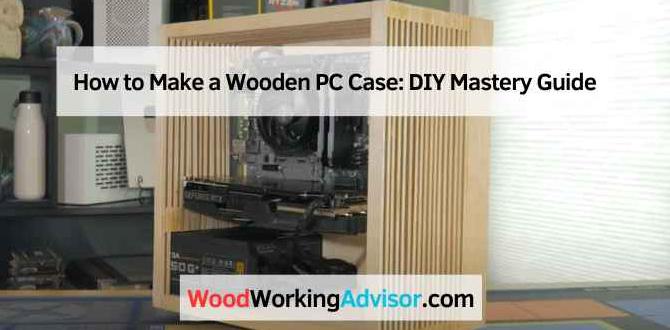Quick Summary:
Safely handling a nail gun misfire means immediately releasing the trigger, removing the battery or disconnecting power, and carefully inspecting the tool and jammed nail without forcing anything. Always prioritize safety by wearing protective gear and consulting your tool’s manual.
Hey there, fellow DIYer! Jack Shaffer here from Nailerguy. We all love how nail guns speed up our projects, right? But sometimes, things don’t go quite as planned. A nail gun misfire, where a nail gets jammed or doesn’t fire properly, can be a bit startling. It’s a common hiccup, and if it happens to you, don’t sweat it! With the right steps, you can handle it safely and get back to building. This guide will walk you through exactly what to do, step-by-step, so you can feel confident and stay safe. We’ll cover everything from what to do the moment it happens to how to prevent future jams.
Table of Contents
Understanding Nail Gun Misfires
A nail gun misfire is essentially when the tool either doesn’t drive a nail fully, drives it at an angle, or fails to drive a nail altogether when you pull the trigger. This can happen for a variety of reasons, from using the wrong type of nail to a build-up of debris in the mechanism. It’s not usually a sign of a major problem, but it’s definitely something you need to address carefully. Ignoring a misfire can lead to deeper jams or even damage to your nail gun.
Common Causes of Nail Gun Misfires
Before we dive into fixing a misfire, let’s take a quick look at why they happen. Understanding the cause can often help prevent them in the future.
- Incorrect Nail Gauge or Length: Using nails that are too long, too short, or not designed for your specific nail gun model is a frequent culprit. Always check your tool’s manual for recommended fasteners.
- Improper Loading: Nails not seated correctly in the magazine can lead to misfeeds and misfires.
- Low Air Pressure (for pneumatic nailers): If your air compressor isn’t supplying enough PSI (pounds per square inch), the nail won’t have the force to be driven properly.
- Battery Issues (for cordless nailers): A weak or dying battery might not provide enough power for a full drive.
- Debris or Dust Buildup: Over time, sawdust and other debris can accumulate inside the tool, interfering with the firing mechanism.
- Worn O-rings or Seals: These vital components can degrade over time, leading to air leaks and reduced power.
- Contact Trip Mechanism Issues: The safety tip (or nose) needs to be pressed firmly against the workpiece to activate the firing mechanism. If it’s worn or obstructed, it might not engage properly.
- Dry Firing: Repeatedly firing the nail gun without sufficient material or pressure can sometimes lead to jams.
Step-by-Step Guide: How to Handle a Nail Gun Misfire Safely
Okay, so you’ve just heard that tell-tale click or thud that signals a misfire. Don’t panic! Follow these crucial steps:
Step 1: Immediately Release Pressure
The very first thing you need to do is take your finger off the trigger. It sounds obvious, but in the surprise of a misfire, your instinct might be to hold it. Releasing the trigger stops the tool from attempting another cycle and potentially worsening the jam or causing injury.
Step 2: Remove Power Source
This is a critical safety step. Depending on your nail gun type, this means one of two things:
- Pneumatic Nailers: Disconnect the air hose from the nailer. This removes the compressed air that powers the tool.
- Cordless Electric Nailers: Remove the battery pack from the tool.
- Corded Electric Nailers: Unplug the tool from the power outlet.
Never try to clear a jam while the nail gun has a power source connected! It’s a serious accident waiting to happen.
Step 3: Wear Safety Gear
Before you get close to the nailer’s mechanism, put on your personal protective equipment (PPE). This includes:
- Safety Glasses or Goggles: Essential to protect your eyes from flying debris or a spring-loaded part.
- Work Gloves: To protect your hands from sharp edges or accidental slips.
It might seem like overkill for a quick fix, but being prepared is always the best approach when working with power tools.
Step 4: Inspect the Nose and Magazine
With the power off and your safety gear on, carefully examine the nose of the nail gun where the nail exits. Look for any nails that are sticking out or bent. Also, check the magazine (where the nails are loaded) for any obvious obstructions or misfed nails.
Step 5: Clearing a Jammed Nail
This is where you’ll actually remove the offending nail. Here’s how to do it:
Method 1: Gentle Extraction
If the nail is sticking out enough and not severely bent, you might be able to gently pull it out with a pair of pliers. Hold the nail firmly with the pliers and try to gently wiggle it back and forth while pulling. Avoid yanking or forcing it, as this could damage the tool.
Method 2: Using the Magazine Release
Some nail guns have a mechanism to help release jams. Check your user manual. Often, you can open up the magazine further or access the firing channel by releasing a latch or lever. This can give you better access to the jammed nail.
If you’re unsure about how to release a specific part of your nailer, consulting your tool’s manual is always the best bet. You can usually find these manuals online if you’ve misplaced your physical copy. For example, DeWalt provides extensive support and manuals for their tools on their official website.
Method 3: Tapping and Jiggling
Sometimes, a stubborn nail might just need a little persuasion. Gently tap the nose of the nail gun against a workbench (make sure the surface won’t be damaged, or place a scrap piece of wood underneath). This jarring motion can sometimes dislodge the nail enough to pull it out with pliers. You can also try gently jiggling the nail gun itself.
Method 4: Utilizing Safety Mechanism (Carefully!)
For some jams, you might need to carefully activate the safety mechanism without having the trigger pulled while the nail is exposed. For instance, by placing the nose against a piece of scrap wood and gently pressing the contact trip. This should only be done if you can clearly see where the nail is jammed and can ensure no part of your hand or body is in the firing path. This is an advanced technique and should be approached with extreme caution. If you’re not comfortable, stick to pliers and manual methods.
Important Note: Never use a screwdriver or other hard objects to pry out a jammed nail if it means reaching far into the firing mechanism. You can damage internal components or cause a more dangerous situation.
Step 6: Reload and Test Fire
Once the jammed nail is removed, inspect the magazine and the firing channel for any remaining debris or damage. If everything looks clear, reload your nail gun according to the manufacturer’s instructions. Before you start on your project again, it’s a good idea to test fire the nail gun into a scrap piece of wood. This ensures it’s firing correctly and that the jam has been resolved.
Troubleshooting Persistent Misfires
If you’ve followed the steps above and your nail gun continues to misfire, it’s time to do a bit more troubleshooting:
Check Your Air Pressure (Pneumatic)
For air-powered nailers, ensure your compressor is set to the correct PSI. Most nail guns require between 70-120 PSI, but always check your manual. Too little pressure is a common cause of weak drives, and sometimes, nails that don’t fully sink can jam on subsequent attempts. You can find recommended PSI ranges for various nail gun types on resources like Woodworking Network, which often share industry best practices.
Inspect the Fasteners
Are you using consistent, high-quality nails? Warped, bent, or improperly sized nails can jam your tool quickly. Sometimes, a brand of nails might be slightly out of spec, and switching to a different, reputable brand can solve the problem entirely.
Clean Your Nail Gun
Dust and debris are the silent killers of tools. Periodically clean the exterior and the magazine of your nail gun. For a deeper clean, you might need to consult your manual about disassembling certain parts. A can of compressed air is great for blowing out loose debris.
Lubrication (Pneumatic Nailers)
Many pneumatic nailers require regular lubrication. A few drops of specialized air tool oil in the air inlet port can keep the internal parts moving smoothly. Refer to your manual for the correct oil type and frequency.
Worn Parts
If your nail gun is older or has seen heavy use, internal parts like O-rings, seals, or the driver blade might be worn. This is often a sign that it’s time for a professional service or repair. The Occupational Safety and Health Administration (OSHA) provides guidelines on tool safety and maintenance that emphasize the importance of keeping tools in good working order to prevent accidents and malfunctions.
Preventing Future Nail Gun Misfires
The best way to handle a nail gun misfire is to prevent it from happening in the first place! Here are some proactive tips:
- Always Use the Correct Fasteners: This is paramount. Check your tool’s manual for the exact size, gauge, and collation type (e.g., paper, plastic, wire collation) of nails it’s designed to use.
- Maintain Proper Air Pressure (Pneumatic): Ensure your compressor is set to the recommended PSI for your nailer. Don’t underestimate the power needed for a clean drive.
- Keep Your Tool Clean: Regularly blow out dust and debris from the magazine and around the nose. A clean tool functions reliably.
- Lubricate Regularly (Pneumatic): Follow the manufacturer’s recommendations for oiling your air-powered nail gun.
- Inspect Nails Before Loading: Quickly scan your nails for any damage or inconsistencies before loading them into the magazine.
- Proper Loading Technique: Make sure nails are seated correctly and the magazine slides smoothly when you load it.
- Avoid Dry Firing: Try not to pull the trigger when there’s no workpiece to nail into, or when the magazine is empty.
- Perform Regular Maintenance: For heavily used tools, consider professional servicing annually.
- Read Your Manual: Seriously, it’s your best friend! Every nail gun is a little different.
Nail Gun Misfire Troubleshooting Table
Here’s a quick reference table to help you diagnose common misfire issues:
| Symptom | Possible Cause | Solution |
|---|---|---|
| Nail not firing at all | No power (battery dead, air hose disconnected, or tripped breaker) | Check power source, battery charge, or air connection. |
| Nail partially fires or sinks shallow | Low air pressure (pneumatic); Weak battery (cordless) | Increase PSI; Charge or replace battery. |
| Nail jams in the magazine or firing channel | Improperly loaded nails; Bent or incorrect nail size; Debris | Reload nails carefully; Inspect and remove jammed nail; Clean tool. |
| Nail drives at an angle | Contact trip mechanism not fully engaged; Not firing directly onto work surface | Ensure nose is pressed flush and square to surface. |
| Tool makes odd noises during firing | Internal wear and tear; Lack of lubrication | Clean, lubricate (if pneumatic), or consider professional service. |
When to Call a Professional or Replace Your Nail Gun
While most misfires are simple fixes, there are times when you might need to seek expert help or consider replacing your tool.
- Persistent Jams: If you’ve tried all the troubleshooting steps and the nail gun continues to jam repeatedly, there might be an internal issue.
- Damaged Firing Mechanism: If you notice significant wear or damage to the driver blade, piston, or other internal components, it’s best to get it professionally inspected.
- Air Leaks: Persistent air leaks from the tool itself (not just the hose connection) can indicate worn seals that are difficult for a beginner to replace.
- Safety Concerns: If you feel the tool is no longer safe to operate, even after basic troubleshooting, trust your gut.
For many DIYers, investing in a new nail gun might be more cost-effective than repairing an older, heavily used model, especially if the repair costs approach the price of a new tool. Reputable brands often have good warranties, so check if your tool is still covered.
Frequently Asked Questions (FAQ) About Nail Gun Misfires
Q1: How do I know if my nail gun is misfiring versus just not firing?
A1: A misfire usually involves the tool attempting to fire but failing to drive the nail correctly, often resulting in a jammed nail or a nail driven poorly. A nail gun that doesn’t fire at all typically means there’s no power getting to the mechanism (e.g., dead battery, disconnected air hose).
Q2: Can I use a regular hammer to dislodge a jammed nail?
A2: No, absolutely not. Using a hammer or other blunt force tools can damage the delicate internal mechanisms of the nail gun and potentially cause injury if a part suddenly releases. Stick to pliers and gentle methods.
Q3: What should I do if a nail is jammed deep inside my nail gun?
A3: If a nail is jammed deeply, and you can’t access it easily with pliers after removing power, consult your user manual for specific jam-clearing instructions. If it’s still inaccessible, it might be time to contact the manufacturer or a tool repair service.
Q4: Is it safe to use my nail gun after a misfire if I’ve cleared the jam?
A4: Yes, provided you’ve followed all the safety steps. After clearing the jam, reload the tool, and always perform a test fire into a scrap piece of wood to ensure it’s working correctly before resuming your project.
Q5: My nail gun keeps jamming. Is it broken?
A5: Repeated jamming often indicates an underlying issue like incorrect nail use, insufficient power (air or battery), or the need for cleaning and maintenance. Try addressing these common causes first. If the problem persists, the tool may require professional servicing.
Q6: How often should I clean my nail gun?
A6: For light DIY use, a quick blow-out of dust after each project is usually sufficient. For more frequent use, a more thorough cleaning, including the magazine and around the nose, every few months is recommended. Check your manual for specific cleaning advice.
Conclusion
Dealing with a nail gun misfire can be a bit of a nuisance, but it doesn’t have to be a dangerous or frustrating experience. By staying calm, prioritizing safety, and following these straightforward steps, you can confidently clear jams and get back to building. Remember, the key is to always disconnect the power source, wear your protective gear, and handle the tool with care. Regular maintenance and using the correct fasteners are your best defense against future misfires. So, the next time your nail gun acts up, you’ll know exactly what to do! Happy building, and stay safe out there!


